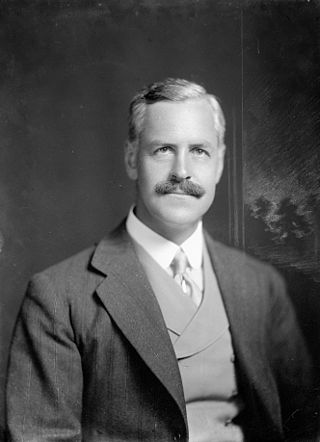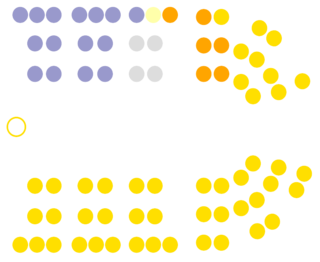| ||||||||||
| Turnout | 4,017 | |||||||||
|---|---|---|---|---|---|---|---|---|---|---|
| ||||||||||
| ||||||||||
The Thames by-election of 1909 was a by-election held during the 17th New Zealand Parliament.
| ||||||||||
| Turnout | 4,017 | |||||||||
|---|---|---|---|---|---|---|---|---|---|---|
| ||||||||||
| ||||||||||
The Thames by-election of 1909 was a by-election held during the 17th New Zealand Parliament.
The by-election was caused after the resignation of Liberal Party MP James McGowan, who had been appointed to the Legislative Council. McGowan announced his resignation by advertisement in the Thames Star on 7 January 1909, and in the same edition, the Mayor of Thames, Archibald Burns, announced his candidacy. [1]
In the end, five candidates contested the election, but Burns was not among them. William Henry Lucas, a unionist, was the official representative of the liberal government. [2] [3] Edmund Taylor and Thomas William Rhodes were also Liberal Party member. [2] Frederick Henry Haselden was the official candidate of the conservative opposition, but Ernest Deeble also stood for opposition interests. [2] [4] [5]
The following table gives the election results:
| Party | Candidate | Votes | % | ±% | |
|---|---|---|---|---|---|
| Liberal | Edmund Taylor | 1,305 | 34.44 | ||
| Liberal | William Henry Lucas | 853 | 22.51 | ||
| Conservative | Ernest Deeble | 573 | 15.12 | ||
| Liberal | Thomas William Rhodes | 565 | 14.91 | ||
| Conservative | Frederick Henry Haselden | 493 | 13.01 | ||
| Turnout | 3,789 | ||||
The Second Ballot Act 1908 was in force and had previously been used for the 1908 election. This was the first by-election where it applied, and the act stipulated that the leading candidate had to obtain an absolute majority of the votes, or else the two highest polling candidates would face each other in a second election. At the 28 January election, Taylor was the highest-polling candidate, but received only 34% of the vote, hence a second election between him and Lucas was required. [2] That election was held on 4 February 1909, and was won by Taylor. [6]
| Party | Candidate | Votes | % | ±% | |
|---|---|---|---|---|---|
| Liberal | Edmund Taylor | 2,241 | 55.79 | ||
| Liberal | William Henry Lucas | 1,776 | 44.21 | ||
| Turnout | 4,017 | ||||
A week after the election, William Massey announced that the opposition will from now on be known as the Reform Party. [8] Taylor served until the end of the parliamentary term and was narrowly beaten by Rhodes at the next general election in 1911. [9] Taylor contested the electorate again in 1914 but Rhodes remained successful. [10]

The 1893 New Zealand general election was held on 28 November and 20 December in the European and Māori electorates, respectively, to elect 74 MPs to the 12th session of the New Zealand Parliament. The election was won by the Liberal Party, and Richard Seddon became Prime Minister.

The 1896 New Zealand general election was held on Wednesday, 4 December in the general electorates, and on Thursday, 19 December in the Māori electorates to elect a total of 74 MPs to the 13th session of the New Zealand Parliament. A total number of 337,024 (76.1%) voters turned out to vote.

James McGowan was a New Zealand politician of the Liberal Party.
Bay of Islands is a former New Zealand parliamentary electorate. It existed during various periods between 1853 and 1993. It was thus one of the original 24 electoral districts, and New Zealand's first ever MP was elected, although unopposed, in the Bay of Islands; Hugh Carleton thus liked to be called the Father of the House.
Avon is a former New Zealand parliamentary electorate. It was created for the 1861 general election and existed until 1996. It was represented by 13 Members of Parliament and was held by Independents, Liberal Party or Labour Party representatives.
Thames is a former New Zealand electorate, in the Thames-Coromandel District. It existed from 1871 to 1946.

Henry James Greenslade was a Liberal Party Member of Parliament in New Zealand.

Vernon Herbert Reed was a Liberal Party and from 1912 a Reform Party member of parliament in New Zealand. He was later a member of the Legislative Council.

Edmund Harvey Taylor was a Liberal Party Member of Parliament in New Zealand.
Wellington, was a parliamentary electorate in Wellington, New Zealand. It existed from 1853 to 1905 with a break in the 1880s. It was a multi-member electorate. The electorate was represented, over the years, by 24 members of parliament.
Christchurch was a parliamentary electorate in Christchurch, New Zealand. It existed three times. Originally it was the Town of Christchurch from 1853 to 1860. From the 1860–1861 election to the 1871 election, it existed as City of Christchurch. It then existed from the 1875–1876 election until the 1881 election. The last period was from the 1890 election to the 1905 election. Since the 1946 election, a similarly named electorate called Christchurch Central has been in existence.

The 12th New Zealand Parliament was a term of the New Zealand Parliament. It was elected at the 1893 general election in November and December of that year.

The 13th New Zealand Parliament was a term of the New Zealand Parliament. It was elected at the 1896 general election in December of that year.

The Mayor of Thames officiated over the Thames Borough of New Zealand, which was administered by the Thames Borough Council. The office existed from 1874 until 1975, when Thames Borough and Coromandel County were amalgamated to form Thames-Coromandel District. There were 24 holders of the office.
The Otaki by-election of 1900 was a by-election during the 14th New Zealand Parliament. The election was held on 6 January following the death of Henry Augustus Field, and was won by his brother William Hughes Field.
The 1915 Bay of Islands by-election was a by-election held on 8 June 1915 during the 19th New Zealand Parliament in the Northland electorate of Bay of Islands. The by-election came about because Vernon Reed's win in the 1914 general election was declared void by an electoral court. The seat was won by William Stewart of the Reform Party. Reed, who was also of the Reform Party, was barred by the court from standing for election for 12 months.
The City of Christchurch by-election of 1896 was a by-election held on 13 February 1896 during the 12th New Zealand Parliament in the urban seat of the City of Christchurch. The by-election was triggered by the appointment of William Pember Reeves as Agent-General to the United Kingdom. The Liberal Government led by Richard Seddon had trouble finding a suitable candidate and delayed Reeves' resignation until the day he left his home in Christchurch to take up the London post. Nonetheless, rumours of Reeves' pending resignation had been circulating for a month and candidates were lining up. The Liberal Party candidate who was secured resigned within a week of Reeves' eventual resignation, and a new candidate had to be found. Three candidates contested the election: Richard Molesworth Taylor was the official Liberal Party candidate, Tommy Taylor was a prohibitionist also with liberal views but an ardent opponent of Seddon, and Charles Lewis was the reluctant conservative candidate of the opposition. Being a Liberal Party stronghold, vote splitting between those candidates who held liberal views secured the election win for Lewis, with the Liberal Party candidate coming last.
The City of Christchurch by-election of 1901 was a by-election held on 18 July 1901 during the 14th New Zealand Parliament in the urban seat of the City of Christchurch. The by-election was triggered by the resignation of conservative politician Charles Lewis and won by George John Smith.
The April 1865 Bruce by-election was a New Zealand by-election held in the multi-member electorate of Bruce during the 3rd New Zealand Parliament on 8 April 1865. It was triggered on 9 January that year by the resignation of separationist Thomas Gillies and won by prominent settler Arthur John Burns. The more liberal businessman William John Dyer was the sole other contester of the by-election, finishing with 43.33% of the vote.